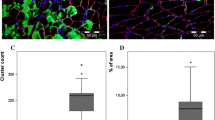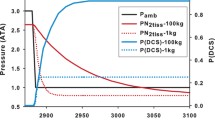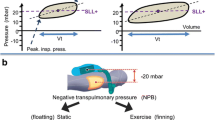Summary
The effects of exercise on the incidence of decompression sickness (DCS) are not completely understood. This paper reviews studies that have addressed this question. Studies have involved exposures of animals and human subjects to high pressures, which would occur in SCUBA diving operations, and to low pressures, which exist during high-altitude aircraft flights and extravehicular activities during space flight. The temporal course of the exercise in relation to the decompression procedure and the nature of the exercise may influence effects on DCS incidence. Effects of exercise on the uptake and elimination of nitrogen, the production of bubbles due to limb movements, the potential role of carbon dioxide, and current plans for further research are discussed.
Similar content being viewed by others

References
Adams JD, Olson RM, Dixon GA (1979) Use of the Doppler precordial bubble detector in altitude decompression. Aerospace Medical Association Annual Scientific Meeting Preprints. Aerospace Medical Association, Washington, DC, pp 260–261
Adams JD, Olson RM, Dixon GA, Fitzpatrick EL (1980) Advanced warning of the potential risk of developing bends and screening of bends prone individuals. Aerospace Medical Association Annual Scientific Meeting Preprints. Aerospace Medical Association, Washington, DC, pp 8–9
Baldin UI (1973) Effects of ambient temperature and body position on tissue nitrogen elimination in man. Aerosp Med 44:365–370
Balke B (1954) Rate of gaseous nitrogen elimination during rest and work in relation to the occurrence of decompression sickness at high altitude. USAF School of Aviation Medicine Project No. 21-1201-0014, Report No. 6
Barcroft J, Douglas CG, Kendal LP, Margaria R (1931) Muscular exercise at low barometric pressures. Arch Sci Biol (Napoli) 16:609–615
Barcroft H, Dornhorst AC (1949) The blood flow through the human calf during rhythmic exercise. J Physiol (Lond) 109:402–411
Behnke AR, Willmon TL (1941) Gaseous nitrogen and helium elimination from the body during rest and exercise. Am J Physiol 131:619–626
Benzinger T, Hornberger W (1941) Die Druckfallkrankheit der Höhenflieger. Schr Dtsch Akad Luftfahrtforsch, No. 34 (cited in Hornberger 1950)
Blinks LIZ, Twitty VC, Whitaker DM (1951) Animal experiments on bubble formation. Part 11. Bubble formation in frogs and rats. In: Fulton JF (ed) Decompression sickness. Saunders, Philadelphia, pp 145–164
Boycott AE, Damant GCC, Haldane JS (1908) The prevention of compressed-air illness. J Hyg 8:342–443
Catchpole HR, Gersh I (1946) Bubble formation in rabbits decompressed to altitude: effect of preoxygenation, electrical stimulation, and some pharmacological factors. J Cell Comp Physiol 27:27–34
Cerretelli P, Marconi C (1968) Blood flow in exercising muscles. Adv Cardiol 35:65–78
Cerretelli P, Pendergast D, Marconi C, Piiper J (1986) Blood flow in exercising muscles. Int J Sports Med [Suppl] 7:29–33
Clamann HG (1971) Decompression sickness. In: Randel HW (ed) Aerospace medicine. Williams and Wilkins, Baltimore, pp 99–117
Conkin J, Waligora JM, Horrigan DJ Jr, Hadley AT III (1984) Comparison of venous gas emboli and decompression sickness incidence in exercising subjects and sedentary Doppler technicians during exposure to 4.3 psia. Aviat Space Environ Med 55:452
Conkin J, Waligora JM, Horrigan DJ Jr, Hadley AT III (1987) The effect of exercise on venous gas emboli and decompression sickness in human subjects at 4.3 psia. (NASA Publication TM-58278). National Aeronautics and Space Administration - Johnson Space Center, Houston
Cook SF (1951) Environmental factors affecting decompression sickness. Part II. Role of exercise, temperature, drugs and water balance in decompression sickness. In: Fulton JF (ed) Decompression sickness. Saunders, Philadelphia, pp 223–241
Cook SF, Williams OL, Lyons WR, Lawrence JH (1944) A comparison of altitude and exercise with respect to decompression sickness. War Med 6:182–187
Dick AP, Vann RD, Mebane GY, Feezor MD (1984) Decompression induced nitrogen elimination. Undersea Biomed Res 11:369–380
Dixon GA, Adams JD, Harvey WT (1986) Decompression sickness and intravenous bubble formation using a 7.8 psia simulated pressure-suit environment. Aviat Space Environ Med 57:223–228
Ellsberg E (1929) On the bottom. Dodd, Mead, New York
Evans A, Walder DN (1969) Significance of gas micronuclei in the aetiology of decompression sickness. Nature 222:251–252
Ferris EB, Engel GL (1951) The clinical nature of high altitude decompression sickness. In: Fulton JF (ed) Decompression sickness. Saunders, Philadelphia, pp 4–52
Ferris EB, Webb JP, Ryder HW, Engel GL, Romano J, Blankenhorn MA (1943) The importance of straining movements in electing the site of the bends. US National Research Council Committee on Aviation Medicine, Report 121, Washington, DC
Fructus X, Lemaire C, Sicardi F, Gardette B (1975) Influence de l'exercice et effet d'un anti-histaminíque sur la décompression. Ètude preliminaire chez le chien. Bull Medsubhyp 12:87–94
Gerth WA, Vann RD, Leatherman NE, Feezor MD (1987) Effects of microgravity on tissue perfusion and the efficacy of astronaut denitrogenation for EVA. Aviat Space Environ Med [Suppl] 58:A100-A105
Gray JS (1943) The effect of exercise at altitudes on aeroembolism in cadets. US National Research Council Committee on Aviation Medicine, Report 169, Washington, DC
Gray JS (1946) Present status of the problem of decompression sickness. Project No. 450, Report No. 1. School of Aviation Medicine. Randolph Air Force Base, Texas
Gray JS, Masland RL (1946) Studies on altitude decompression sickness. II. The effects of altitude and of exercise. J Aviat Med 17:483–493
Harris M, Berg WE, Whitaker DM, Twitty VC (1945a) The relation of exercise to bubble formation in animals decompressed to sea level from high barometric pressures. J Gen Physiol 28:241–251
Harris M, Berg WE, Whitaker DM, Twitty VC, Blinks LR (1945b) Carbon dioxide as a facilitating agent in the initiation and growth of bubbles in animals decompressed to simulated altitudes. J Gen Physiol 28:225–240
Harvey EN, Barnes DK, McElroy WD, Whiteley AH, Pease DC, Cooper KW (1944) Bubble formation in animals. I. Physical factors. J Cell Comp Physiol 24:1–22
Heimbach RD, Sheffield PJ (1985) Decompression sickness and pulmonary overpressure accidents. In: DeHart RL (ed) Fundamentals of aerospace medicine. Lea & Febiger, Philadelphia, pp 132–161
Henry FM (1946) The role of exercise in altitude pain. Am J Physiol 145:279–284
Henry FM (1956) Effects of exercise and altitude on the growth and decay of aviator's bends. J Aviat Med 27:250–259
Hill L (1912) Caisson sickness and the physiology of work in compressed air. Arnold, London
Hornberger W (1950) Decompression sickness. In: US Air Force (ed) German aviation medicine in World War 11. US Government Printing Office, Washington, DC, pp 354–394
Horrigan DJ, Waligora JM, Nachtwey DS (1985a) Physiological considerations for EVA in the Space Station era. Proceedings of Fifteenth Intersociety Conference on Environmental Systems, San Francisco, California (SAE Technical Paper 851313)
Horrigan DJ Jr, Waligora JM, Stanford J (1985b) A physiological evaluation of Space Shuttle extravehicular activities. Aviat Space Environ Med 56:484
Howard JM, Sheffield PJ, Matos LA (1982) Altitude decompression sickness incidence in the US Air Force. Undersea Biomed Res [Suppl] 9:10
Ikels KG (1970) Production of gas bubbles in fluids by tribonucleation. J Appl Physiol 28:524–527
Jauchem JR (1986) Pharmacologic intervention to prevent decompression sickness (DCS). Gen Pharmacol 17:619–623
Jauchem JR, Waligora JM, Conkin J, Horrigan DJ Jr, Johnson PC Jr (1986a) Blood biochemical factors in humans resistant and susceptible to formation of venous gas emboli during decompression. Eur J Appl Physiol 55:68–73
Jauchem JR, Waligora JM, Taylor GT, Horrigan DJ Jr, Johnson PC Jr (1986b) Hematological changes following repetitive decompressions during simulated extravehicular activity. Int Arch Occup Environ Health 58:277–285
Krutz RW, Dixon GA (1987) The effects of exercise on bubble formation and bends susceptibility at 9,100 m (30,000 ft; 4.3 psia). Aviat Space Environ Med [Suppl] 58:A97-A99
Lanphier EH (1975) Pulmonary function. In: Bennett PB, Elliott DH (eds) The physiology and medicine of diving, 2nd ed. Williams & Wilkins, Baltimore, pp 307–330
Lundin G, Thomson D (1966) Cardiac output in the supine and sitting position determined by a CO2 method. Acta Physiol Scand 66:129–132
MacDonald JW, Pilmanis AA (1981) Carbon dioxide retention with underwater work in the open ocean. In: Bachrach AJ, Matzen MM (eds) Underwater physiology VII. Undersea Medical Society, Inc, Bethesda, Maryland, pp 197–207
MacKenzie CG, Reisen AH (1944) The production by moderate exercise of a high incidence of bends. J Am Med Assoc 124:499–501
Maio DA, Allen TH, Bancroft RW (1970) Decompression sickness and measured levels of exercise on simulated Apollo missions. Aerosp Med 41:1162–1165
Malconian MK, Rock P, Devine J, Cymerman A, Sutton JR, Houston CS (1987) Operation Everest II: altitude decompression sickness during repeated altitude exposure. Aviat Space Environ Med 58:679–682
McDonough PM, Hemmingsen EA (1984a) Bubble formation in crustaceans following decompression from hyperbaric gas exposures. J Appl Physiol 56:513–519
McDonough PM, Hemmingsen EA (1984b) Bubble formation in crabs induced by limb motions after decompression. J Appl Physiol 57:117–122
McDonough PM, Hemmingsen EA (1985) Swimming movements initiate bubble formation in fish decompressed from elevated gas pressures. Comp Biochem Physiol 81A:209–212
Olson RM, Adams JD, Fitzpatrick EL (1978) Ultrasonic monitoring of altitude decompressions. Aerospace Medical Association Annual Scientific Meeting Preprints. Aerospace Medical Association, Washington, DC, pp 105–106
Paton WDM, Walder DN (1954) Compressed air illness. Special Report, Medical Research Council No. 281. HMSO, London
Pezzi M (1937) Der Höhenflug (Il volo in alta). Lilienthal-Gesellsch, p 52 (cited in Hornberger 1950)
Pfleiderer H (1944) Bemerkungen zur Druckfallkrankheit. Unpublished manuscript (cited in Hornberger 1950)
Pilmanis AA, Christopherson SK, Dwyer HJ (1976) The effect of “at-depth” exercise on the formation of venous gas emboli in man during and after compressed air ocean diving. In: Proc 3rd annual meeting North Pacific Chapter of the Undersea Medical Society, June 1976. High Pressure Life Laboratory, University of North Dakota, Grand Forks, North Dakota, p 39
Schaefer KE (1975) Carbon dioxide effects under conditions of raised environmental pressure. In: Bennett PB, Elliott DH (eds) The physiology and medicine of diving, 2nd ed. Williams & Wilkins, Baltimore, pp 185–206
Schibli RA, Buhlmann AA (1972) The influence of physical work upon decompression time after simulated oxy-helium dives. Helv Med Acta 36:327–342
Schubert G, Grüner A (1939) Die Entstehung freier Gase in Blut und Geweben bei rascher Dekompression. Klin Wochenschr 36:988–990
Slonim NB, Bender NK (1974) Responses to carbon dioxidecontaining atmospheres. In: Slonim NB (ed) Environmental physiology. C. V. Mosby, St. Louis, pp 437–476
Smedal HA, Brown EB Jr, Hoffman CE (1946) Incidence of bends pain in a short exposure to simulated altitudes of 26000, 28000 and 30000 feet. J Aviat Med 17:67–79
Spencer MP, Johanson DC, Campbell SD (1976) Safe decompression with the Doppler ultrasonic blood bubble detector. In: Lambertsen CJ (ed) Underwater physiology V. Federation of American Societies for Experimental Biology, Bethesda, Maryland, pp 311–325
Theis CF, Adams JD, Stevens KW (1979) Nitrogen washout in the supine position. Aerospace Medical Association Annual Scientific Meeting Preprints. Aerospace Medical Association, Washington, DC, pp 262–263
Van der Aue OE, Kellar RJ, Brinton ES (1949) The effect of exercise during decompression from increased barometric pressures on the incidence of decompression sickness in man. US Navy Experimental Diving Unit Research Report No. 8-49
Van der Aue OE, Kellar RJ, Brinton ES, Barron G, Gilliam HD, Jones RJ (1951) Calculation and testing of decompression tables for air dives employing the procedure of surface decompression and the use of oxygen. US Navy Experimental Diving Unit Report No. 13-51
Vann RD (1979) The effect of exercise on decompression. Undersea Biomed Res [Suppl] 6:18
Vann RD (1982) Decompression theory and applications. In: Bennett PB, Elliott DH (eds) The physiology and medicine of diving, 3rd ed. Best Publishing Co, San Pedro, California, pp 352–382
Walder DN (1969) The prevention of decompression sickness in compressed-air workers. In: Bennett PB, Elliott DH (eds) The physiology and medicine of diving and compressed air work. Williams & Wilkins, Baltimore, pp 437–450
Waligora JM, Horrigan DJ (1975) Metabolism and heat dissipation during Apollo EVA periods. In: Johnston RS, Dietlein LF, Berry CA (eds) Biomedical results of Apollo (NASA Publication SP-368). National Aeronautics and Space Administration, Washington, DC
Waligora JM, Horrigan DJ (1977) Metabolic cost of extravehicular activities. In: Johnston RS, Dietlein LF (eds) Biomedical results from Skylab (NASA Publication SP377). National Aeronautics and Space Administration, Washington, DC
Waligora JM, Horrigan DJ, Jauchem JR, Conkin J (1984a) Detection of incipient altitude decompression sickness with Doppler sensors in flight. In: Goodhart ME (ed) Research and technology annual report — 1984 (NASA Publication TM-58263). National Aeronautics and Space Administration — Johnson Space Center, Houston, p 74
Waligora JM, Horrigan D Jr, Conkin J, Hadley AT III (1984b) Verification of an altitude decompression sickness prevention protocol for Shuttle operations utilizing a 10.2-psi pressure stage (NASA Publication TM-58259). National Aeronautics and Space Administration — Johnson Space Center, Houston
Waligora JM, Horrigan DJ Jr, Conkin J, Jauchem JR (1985) The effect of multiple simulated extravehicular activity (EVA) decompressions over a 72-hour period on symptom and bubble incidence. Aviat Space Environ Med 56:483
Waligora JM, Horrigan DJ Jr, Conkin J (1987) The effect of extended O2 prebreathing on altitude decompression sickness and venous gas bubbles. Aviat Space Environ Med [Suppl] 58:A110-A112
Webb IT, Smead KW, Jauchem JR, Barnicott PT (1988) Blood factors and venous gas emboli: Surface to 429 mm Hg (8.3 PSI). Undersea Biomed Res 15:107–121
Webb P (1964) Pressure. In: Bioastronautics data book (NASA Publication SP-3006). National Aeronautics and Space Administration, Washington, DC
Whitaker DM, Blinks LR, Berg WE, Twitty VC, Harris M (1945) Muscular activity and bubble formation in animals decompressed to simulated altitudes. J Gen Physiol 28: 213–223
Whiteley AH, McElroy WD (1946) Denitrogenation of muscle and fat tissue of the anesthetized cat. Am J Physiol 146: 229–240
Whiteley AH, McElroy WD, Warren GH, Harvey EN (1944) Bubble formation in animals. V. Denitrogenation. J Cell Comp Physiol 24:257–271
Yamaji K, Mano S, Nada H, Yamanishi J, Shephard RJ (1986) Heart rate overshoot following sustained isometric and repeated isotonic arm flexion and knee extension. J Sports Med 26:331–336
Author information
Authors and Affiliations
Rights and permissions
About this article
Cite this article
Jauchem, J.R. Effects of exercise on the incidence of decompression sickness: a review of pertinent literature and current concepts. Int. Arch Occup Environ Heath 60, 313–319 (1988). https://doi.org/10.1007/BF00405664
Received:
Accepted:
Issue Date:
DOI: https://doi.org/10.1007/BF00405664



